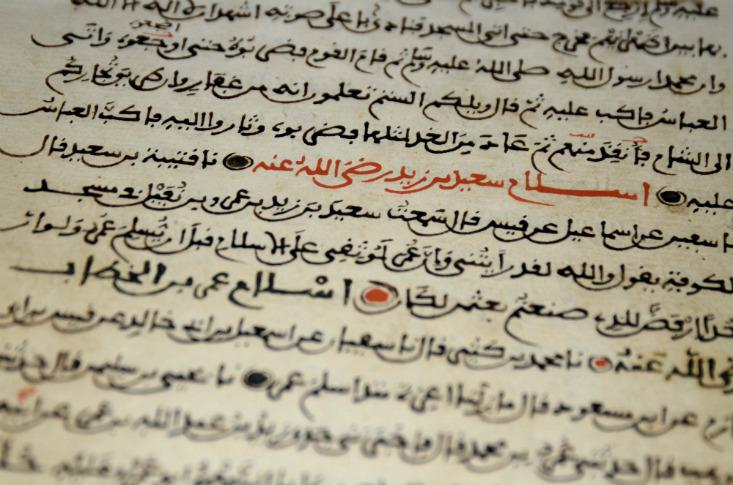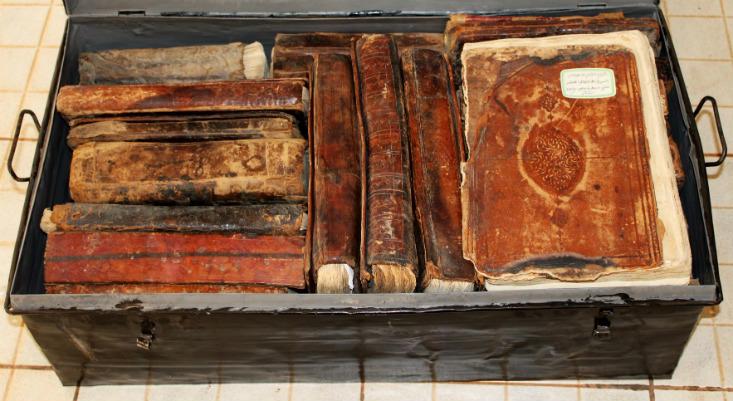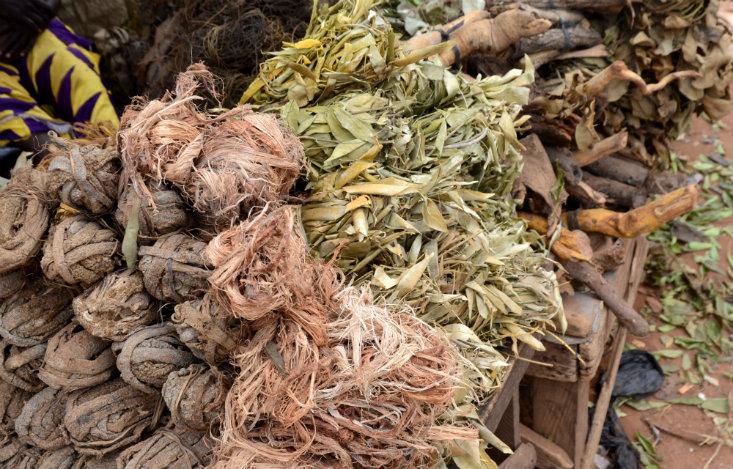
Seven hundred years ago, Timbuktu was a dream destination for scholars, traders, and religious men. At the southern edge of the Sahara desert in what is now Mali, travelers from Europe, sub-Saharan Africa, Egypt, and Morocco met in the bygone metropolis to exchange gold, salt, and ideas. According to a description of Timbuktu in 1526 by the diplomat Leo Africanus, “more profit is to be made there from the sale of books than from any other branch of trade.”
Bundled in camel skin, goat skin, and calf leather, the manuscripts remaining from Timbuktu’s heyday come in an array of sizes. Words from Arabic and African languages, inscribed in gold, red, and jet-black ink, line their pages. Sometimes the text assembles into triangles, or surrounds intricate, geometric designs. I stared at a few ornate pages last September as they were being photographed in an eroded cement building in Mali’s capital, Bamako. Rain pummeled the streets that day, creating pond-size puddles in the dirt road that people would wade through, ankle-deep, without flinching. Upstairs in the building, Abdel Kader Haidara told me how more than 300,000 ancient manuscripts from Timbuktu arrived in Bamako earlier that year.

Haidara wore a rust-colored tunic that reached his ankles and a matching cap, an elegant style typical of men from northern Mali. In an office containing little except for a desk and a rickety bookshelf with a row of books with decorative Arabic across their bindings, he described how his father instructed him to respect the family’s large library. Because of private collections like his, the Timbuktu manuscripts have remained safe with their owners through the generations, rather than ruined or stolen by the parade of powers who have ruled over Timbuktu, including the French, who colonized Mali between 1892 and 1960.
In 1996, Haidara founded an organization to safeguard the manuscripts from weather damage. So when an Al Qaeda-affiliated group invaded Timbuktu last year, destroying tombs and burning any ancient manuscripts they found, Haidara was prepared to help pack his neighbors’ texts into nondescript metal trunks and load them onto donkey carts bound for Bamako. The private collections are now held at an undisclosed location in the city* where scholars might finally, for the first time, lay eyes on them.

Subjects in the collections, spanning the 13th through 17th century, include the Koran, Sufism, philosophy, law, medicine, astronomy, and more. Haidara stresses the need for climate-controlled safe-houses for the manuscripts, so that academics can begin to study the books to learn about African history. He thinks the books might also contain information about cures for maladies that persist today. “Every book has answers, and if you analyze them you can learn solutions,” he says. “Everything that exists now, existed before now.” One prime example of this constancy is a plague that has afflicted humans at least since ancient times and currently kills approximately 1.2 million people per year: malaria.
It’s not yet known whether the texts discuss malaria, but it seems likely based on other ancient texts from the region, says Nikolay Dobronravin, a scholar who studies ancient West African manuscripts at St. Petersburg State University in Russia. Dobronravin says African manuscripts contain many passages on tibb, an Arabic word meaning medicine. In one mode of tibb, a healer or teacher writes words from the Koran onto a thin wooden tablet with charcoal-based ink, and the patient washes the tablet down with water. Other, less mystical treatments involve leaves and animal parts consumed as cures for various ailments. “In the Timbuktu collections, a scholar-doctor might have his own book of recipes, comparable to what you find in a cook’s kitchen,” Dobronravin predicts. Villagers might still use some of those herbal remedies today. In a rural, southeastern region of Mali, I saw bundles of leaves sold in the marketplace. My translator told me that villagers boil the leaves to make teas that calm fevers.

This might sound hopeful, until you speak with mothers who have lost children to malaria. Some of them told me they opted for teas and other traditional medicines when their babies fell ill, rather than consult with nurses or doctors. Then the fevers grew worse, convulsions began, and death came swiftly. It’s unfortunately a common story, and one that makes African doctors and health workers weary of the promises of traditional medicine. Still, Haidara says, ancient recipes in the Timbuktu texts could contain forgotten cures that were lost through the ages.
A malaria scientist and doctor at the University of Dakar in Senegal, Badara Cisse, countered Haidara’s assertion by telling me, “In Africa, we are well behind because we love living with our past.” He has watched children die after traditional healers promised their mothers a cure, and it has molded his drive to deliver better solutions though evidence-based science rather than by digging into history. “We need to be open to the new world,” Cisse says.

Yet modern and traditional medicine have at times worked hand-in-hand. A case in point is the modern gold-standard treatment for malaria, artemisinin. The drug derives from the sweet wormwood plant, Artemisia annua, which is listed among other plants that treat fevers in ancient Chinese texts. It was re-discovered in the 1970s as resistance to the malaria drug chloroquine spread around the globe and malaria deaths steadily rose. To curb the death rate, Chairman Mao encouraged Chinese scientists to evaluate hundreds of folk remedies. By 1990, the teams had systematically tested several malaria therapies that included artemisinin, according to a book by historian Dana Dalrymple. In 2001, the World Health Organization (WHO) recommended the treatments for malaria. Finally, in 2005, the rising annual death toll from malaria began to reverse thanks to use of the wormwood-derived drug.
But a new malaria medicine may be needed in the near future if resistance to artemisinin grows. Already, a few cases of resistance have emerged in southeast Asia. Perhaps a clue lies in the Timbuktu texts, but to find it, scholars and researchers must be able to study their pages. As of now, the manuscripts degrade more with each passing year. Haidara has only a few shields to stave off age, moisture, insects, and fungi. To save the books, he and his colleagues rely on funds raised through an Indiegogo page and other private donations, such as a grant from the New York-based Ford Foundation.
Endlessly shifting sands have eroded what was once the golden metropolis of Timbuktu, just as the rain washes away roads outside of Haidara’s headquarters on the day I visit. The manuscripts may contain knowledge that can save thousands of lives, if scholars and scientists reach them before they dissolve into the past, leaving future generations to scour the plant world all over again.
* Correction: The building where the author met Haidara is not the same building where most of the texts are kept, as the article originally stated.
Amy Maxmen is senior editor at Nautilus. Her trip to Mali was supported by the Pulitzer Center for Crisis Reporting.


























